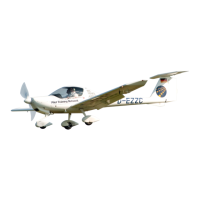
Do you have a question about the Diamond Aircraft Katana DA 20 and is the answer not in the manual?
| Brand | Diamond Aircraft |
|---|---|
| Model | Katana DA 20 |
| Category | Aircrafts |
| Language | English |
Overview of the flight manual's purpose.
Aircraft approval and airworthiness standards.
Definitions of important safety terms.
Visual representation of aircraft dimensions.
Detailed physical specifications of the aircraft.
Details of the Rotax 912S3 engine.
Information on the Hoffmann propeller.
Approved fuel grades and capacity.
Recommendations for oil and coolant.
Aircraft weight limitations and specifications.
Glossary of terms and acronyms used.
Conversion tables for units of measure.
Overview of operating limitations.
Permissible speeds for various flight phases.
Explanation of airspeed indicator color codes.
Engine and propeller operating limits.
Color codes for powerplant instruments.
Color codes for other instruments.
Maximum permissible aircraft weight.
Aircraft CG range and limits.
Permissible aerobatic maneuvers.
Structural load factor limits.
Capacity for passengers.
Minimum flight crew requirements.
Allowed flight operations (VFR).
Fuel capacity and grades.
Required aircraft warning labels.
Maximum demonstrated crosswind.
Operational temperature limits.
Overview of emergency procedures.
Speeds for emergency situations.
Procedures for engine failures.
Procedures for emergency landings.
Procedures for fire incidents.
Procedures for unintentional flight into icing.
Procedures to recover from spins.
Procedures for landing with a flat tire.
Procedures for gliding.
Procedures for electrical system failures.
Procedures for flap system malfunctions.
Procedures for starter malfunctions.
Procedures for avionics system failures.
Procedures for trim system malfunctions.
Procedures for lighting failures.
Procedures for tachometer failures.
Overview of normal operating procedures.
Recommended airspeeds for flight.
Function of the structural temperature indicator.
Detailed preflight inspection steps.
Procedures before engine start.
Step-by-step engine starting procedures.
Procedures before taxiing.
Procedures for taxiing the aircraft.
Procedures for engine run-up.
Procedures for taking off.
Procedures for climbing.
Procedures for cruise flight.
Procedures for descending.
Procedures for landing approach.
Procedures for a balked landing.
Procedures after landing.
Procedures for engine shutdown.
Considerations for flying in rain.
Procedures for spin entry and recovery.
Overview of performance data.
How to use performance charts.
Calibration of airspeed system.
Cruising performance data.
Stall speeds in various configurations.
Wind component calculations.
Take-off distance charts.
Climb performance and service ceiling.
True airspeed for cruise.
Calculation of maximum flight duration.
Climb performance during balked landing.
Landing distance charts.
Aircraft noise levels.
Overview of weight and balance.
Procedures for weighing the aircraft.
Recording weight and balance data.
Calculating flight weight and CG.
List of installed aircraft equipment.
Overview of aircraft systems.
Description of fuselage, wings, and empennage.
Operation of flight controls.
Layout and functions of instruments.
Description of the landing gear system.
Description of seats and belts.
Location and use of baggage compartment.
Operation and locking of the canopy.
Details of the engine and related systems.
Description of the fuel system.
Description of the electrical system.
Description of pitot/static systems.
Description of stall warning system.
Description of avionics equipment.
Overview of handling and maintenance.
Schedule of required inspections.
Procedures for alterations and repairs.
Procedures for moving the aircraft.
Procedures for cleaning aircraft surfaces.
Procedures for ground de-icing.
Introduction to optional equipment supplements.
List of available supplements.
Specific optional equipment details.
Introduction to the winterization kit.
Limitations for using the winterization kit.
Emergency procedures with kit installed.
Normal procedures with kit installed.
Performance with winterization kit.
Weight and balance effect of kit.
